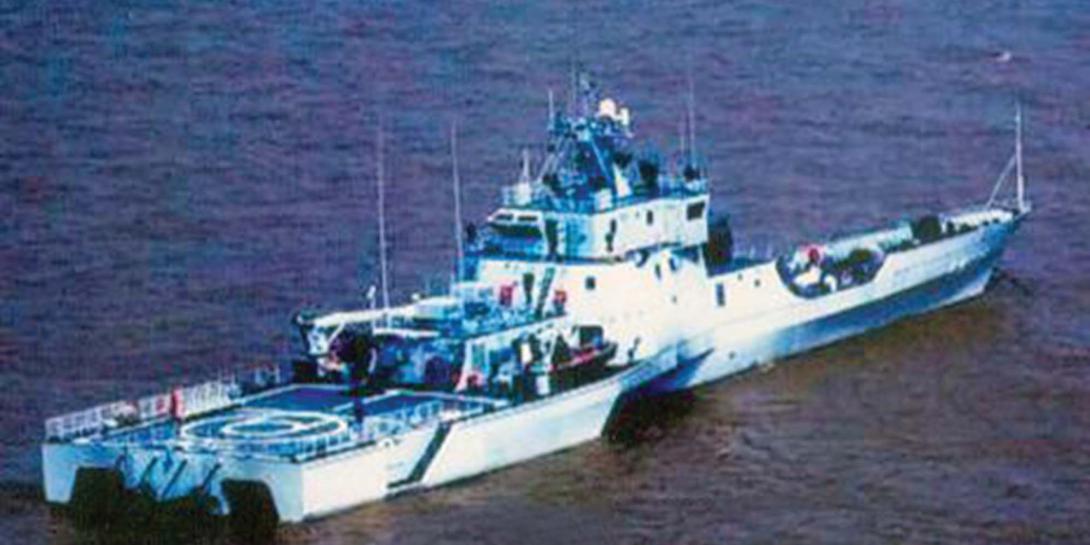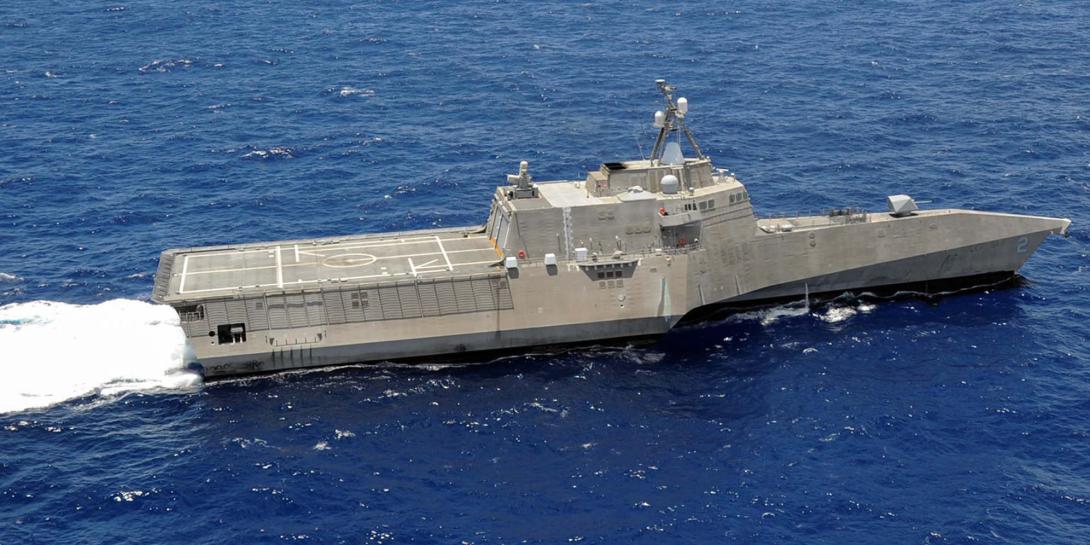Coastal Catamarans Serve Chinese Littoral Needs
China is introducing designs for catamarans—and even trimarans—that seem destined to serve as the country’s littoral combat ships. Some of the trimarans closely resemble their U.S. counterparts, although differences—some quite interesting—do exist.
The news media is saturated with hundreds of highly controversial opinions about and proposed solutions to the complex U.S. Navy Littoral Combat Ship (LCS) program that are intended to meet the many varying goals of numerous committees. Yet the Western media and naval scholars have ignored how the trimaran Chinese LCS (C-LCS) looks exactly like the USS Independence LCS-2, and there are no open literature details on it. Questions are rife over how the two vessels compare in size, systems, mission and purpose.
The first point to clarify is whether a coastal catamaran or trimaran should be a navy fleet asset or under an independent maritime agency. That is clearly defined because the second word of the name on the C-LCS bow is “JIU,” meaning “rescue,” and the first word is either “BEI” (north), “DONG” (east) or “NAN” (southern), indicating fleet affiliation. A three-digit hull number follows those words.
China established the Maritime Safety Administration (MSA) in 1949 and the State Oceanic Administration in 1965, then combined them in a new Chinese Coast Guard (CCG) in 1979. Several different maritime protection agencies were combined in the new CCG in this reorganization. Among the six maritime organizations that had been created by 1998 was a new China Marine Surveillance agency primarily for anti-access/area denial in the South China Sea and the Sea of Japan. The latest organization under the MSA is the Rescue and Salvage group, which was formed in 1999 after 282 lives were lost when a ferry boat capsized in Bohai Bay. This would be the group that the “rescue” vessels would be under. Although the date of its introduction into the Northern fleet is unknown, a 230-ton rescue catamaran, Bei Hai Jiu (North Sea rescue), hull 201, was listed in 2006.
The most notable early Chinese catamarans for littoral operations are the 80 Houbei Type 022 wave-piercing catamarans with potent surface-to-surface missile (SSM) launchers (SIGNAL Magazine, December 2007, page 37, “Catamarans Glide ...”). The possibility of swarm attacks on U.S. forward-deployed Pacific operational major warships certainly is high. The Houbei is 43 meters long (140 feet) with a 1.5-meter (5-foot) draft. These specifications are strikingly close to the Australian AMD 350, which is 42 meters in length with the same draft. The AMD 350 was one of seven AMD catamarans, ranging from 16 meters to 30 meters in length, that China purchased from 1993 to 2000. The Houbei lead vessel “2008” was delivered by Qiuxin Shipyard in Shanghai in 2004, followed three years later by three more hulls.
This ship introduction normally would follow the four-ship design characteristic of five previous guided missile destroyer types since 1991. The tendency to avoid mass production was disproved when series production of 022 catamarans began in four shipyards, as China added Dalian, Jiangnan and Huangpu shipyards to build the vessels. Production continued to the current count of nearly 80 catamaran missile boats. Such massive production rates had not been seen since China copied 120 Russian subs, 16 Luda destroyers and hundreds of Shanghai patrol boats from the 1950s to the 1970s.
China’s attempts to export these catamarans to nations on the U.S. terrorist list were unsuccessful except for a 14-meter, 19-ton boat sold to Iran. The West was surprised to see photos emerge of the small C-LCS, and data on when and where the boats were built is elusive—probably because Western surveillance satellites were busy monitoring the big tonnage carrier, SSN and SSBN submarines, guided missile destroyers and large amphibious hulls rather than watching “innocuous small catamaran” vessels in the crowded Chinese shipyards.
An educated guess for initial production and design would be Qiuxin Shipyard, which was selected for the very successful 022 catamaran program. The Afai Southern Shipyard in Guangzhou, established in 1992, has been producing dozens of catamarans since 1999. Although many are high-speed ferries, several are 30-meter to 40-meter rescue vessels. The initial hazy gray photos of hull numbers 143 and 335—“trimarans” with 30-millimeter guns alongside piers—probably date back to 2012. Fleet assignment with “jiu” naming would occur in 2013, but the catamarans were not openly photographed—and seen on open blogs—until 2014.
At first glance, the paucity of topside equipment may seem not very informative, but the equipment not shown reveals as much about the purpose and capabilities of the boats as what is observed. In estimating the hull of the C-LCS, the size correlates to displacement and range without refueling and limits of the mission alone. The few discussions on this catamaran suggest it is smaller than the U.S. Navy LCS-2. Without photos of the C-LCS alongside other vessels of known dimensions, the only reference sizes are crew members or a topside rescue boat. One estimate is that the vessel is 240 feet long with a 600-ton displacement, compared with 418 feet and 2,000-3,000 tons for the LCS-2.
The Chinese vessel has no long-range radars or offensive or defensive topside launchers of missiles or decoys. The only topside weapon is an apparent multibarrel close-in weapon system (CIWS) on the forecastle. The basic 30-millimeter gun with seven barrels would be expected, as on destroyers. In the few extant close-up pictures, the gun has a canvas cover with only the round base and rather large diameter barrel observed outside the cover. A single raised object, probably a local director, is in the middle of the cover. Prior Chinese Type 730 seven-barrel guns seen on Chinese warships had two vertical directors on the outer sides; by comparison, the imported Dutch seven-barrel Goalkeeper has a single director dish above a rectangular mount. A more distant picture of the bow shows the gun with a two-layer mount, the wider top layer being rectangular with a curved bottom, over a narrower rectangle with the gun barrel in the front.
Rather than have a single gun or missile design on all sizes of warships as do most navies, the Chinese have made different designs for large and smaller ships. For example, their aircraft carrier has a larger 11-barrel Gatling gun, designated Type 1130, rather than the seven-barrel Type 730 on smaller warships. This unique Chinese tendency suggests that the Chinese designed a smaller, lighter Type 730 with only one local director on top for the small catamaran. That would match the outline under the cover.
The only military datalink is the two-way HN-900, similar to the Western Link 11, on the starboard yardarm. The same as on the 022, these datalinks enable integrated operations with larger naval ships that also have the link. An electro-optical camera or rangefinder is on the mast, probably a Kolonika II low-light-level optical gun director. A 5-foot-tall object found centerline forward on the bridge is covered in close-up photographs, but it could be a director for the CIWS because both usually are covered in port. The navigation radar, probably the Type 756, and several whip antennas are common with other maritime protection vessels. But the high number and variety of bandwidths included in the population of whip antennas are unusual for a small rescue vessel.
Two 6-meter rigid hull inflatable boats (RHIBs) for boarding and rescue operations are on the port and starboard sides with their own rotating boom hoist in most photos. The LCS-2 mainframe has a 7-meter RHIB, and the surface warfare mission module includes one or two 11-meter special operations RHIB boats that carry eight special operations forces in addition to the three-member crew. The C-LCS seems undersize for its boarding and rescue missions, but carrying two RHIBs compensates. The topside RHIB boats and booms are not in some photographs. Whether they can be stowed internally is not clear.
The propulsion on the C-LCS appears to be the usual four water jets and two diesel engines, similar to the 022, although the earlier 022 had the water jets in the two outboard foils with no hull between them. The C-LCS has all four water jets adjacent in the central hull, as in the U.S. LCS-2. The larger and heavier U.S. Navy trimaran LCS-2 and experimental 1,600-ton FSF Sea Fighter used dual turbine and combined diesel and gas turbine (CODAG) propulsion with four water jets. The 338-foot, 1,515-ton Joint High-Speed Vessel (JHSV) catamaran used four MTU 20V 8000 diesel engines. The diesel engines in the C-LCS probably are the French S.E.M.T. Pielstick 16 PA6 STC imported versions or licensed Chinese copies by Shaanxi Diesel Engine plant. The lack of warship electronic warfare, anti-air warfare, antisubmarine warfare or antisurface warfare weapons and sensors indicate low manning levels. The unusually high number and variety of communication whip antennas would not increase crew size.
China’s coastal warfare plan already is visible in its 80 Houbei catamaran missile boats and recent monohull frigate models 054 and 056 with respectable multiwarfare capabilities. The People’s Liberation Army Navy Maritime Protection and Coast Guard rescue plan is apparent in the 1,000-vessel Fourth Fleet activities for several years in the South and East China seas and the Sea of Japan. This raises the question of why China would produce a few small trimaran rescue vessels copied externally from the LCS-2 without warship modules and 40 percent smaller. The U.S. Navy and Congress already are weaponizing and eliminating embark and debark evolutions of mission modules and minimum manning for future revised frigate or surface combatant production.
James C. Bussert, employed at the Naval Surface Warfare Center in Dahlgren, Virginia, is the co-author of People’s Liberation Army Navy: Combat Systems Technology, 1949-2010. The opinions expressed in this article do not necessarily reflect the views of the U.S. Defense Department or the U.S. Navy.






Comments